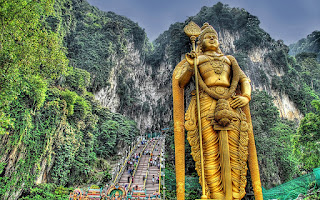Located approximately 11 kilometres to the north of Kuala Lumpur, Batu Caves is a limestone hill comprising three major caves and a number of smaller ones. Considered one of Kuala Lumpur’s most frequented tourist attractions, this 100-year-old temple features idols and statues erected inside the main caves and around it. Incorporated with interior limestone formations said to be around 400 million years old, the temple is considered an important religious landmark by Hindus.
Cathedral Cave – the largest and most popular cavern in Batu
Caves – houses several Hindu shrines beneath its 100-metre-high arched ceiling.
At the foot of Batu Hill are two other cave temples – the Art Gallery Cave and
Museum Cave – which houses numerous Hindu statues and paintings.
Batu Caves is the focal point of the annual Hindu festival of
Thaipusam, which attracts thousands of devotees and visitors. Usually held at
the end of January, the procession begins on the evening before the Thaipusam
Festival at the Sri Mariamman Temple in KL city centre.
The procession more often than not, arrives at Batu Caves in
the wee hours of the morning the next day; the entire celebration commences
then and is a colourful event that lasts a total of eight hours. In the past
the festival has attracted more than one million pilgrims, making it one of the
largest gatherings in the world.
Many disciples carry their offerings – containers of milk –
to the Lord Muruga on large, brightly decorated ‘kavadis’. Kavadis are two huge
semicircular ornate pieces of wood or steel which are bent and attached to a
cross structure that can be balanced on the shoulders. These frameworks are
also usually combined with various metal hooks and skewers which are used to
pierce the skin, cheeks and tongue. The kavadi is decorated with flowers and
peacock feathers and some can weigh up to as much as 100 kilos.
Some disciples also fulfil vows that they have made to the
Gods by having their bodies pierced by hooks, needles and even skewers and
visitors are often fascinated by the dedication of devotees.
The truly amazing feat is when followers begin the arduous climb
up the 272 steps to the top of the caves – the trek requires a stunning amount
of endurance as they often have to work against the press of the bustling
masses. Priests wait at the top to sprinkle consecrated ash over the hooks and
skewers piercing the devotees flesh before they are removed.
黑风洞
黑风洞是印度教的朝拜圣地,位于吉隆坡北郊11公里处,是一个石灰岩溶洞群,处在丛林掩映的半山腰,从山下循272级陡峭台阶而上即可到达,也有缆车直抵洞口。通常也作为游戏中的副本场景名称和地图名称使用。
黑风洞是印度教的朝拜圣地,位于吉隆坡北郊11公里处,是一个石灰岩溶洞群,处在丛林掩映的半山腰,从山下循272级陡峭台阶而上即可到达。
黑风洞是在100多年前被发现的,该处石灰岩面积255公顷,洞穴不下20处,以黑洞和光洞最为有名。黑洞阴森透凉,小径陡峭,曲折蜿蜒,长达2公里多,栖息着成千上万的蝙蝠、白蛇和蟒蛇等150多种动物。光洞紧邻黑洞,高50—60米,宽70—80米,阳光从洞顶孔穴射入,扑朔迷离。光洞附近一个洞穴中有1891年建的印度教庙宇,供奉着苏巴玛廉神,还有成百尊的彩绘神像。山下有洞窟艺术博物馆,展示包括神像壁画在内的印度神话文物。登上山顶,可远眺橡胶园和锡矿山。
黑风洞与摈城的穆尔干寺同为马来西亚的印度教圣地,每年阴历1—2月间的大宝森节(固定的三天内举行)期间,虔诚的印度教徒用钢针穿过皮肤,面颊和舌头上用小刀、小叉刺穿,背负神像,唱着宗教圣歌游行步入石洞参拜,为期3天,朝圣者可达30万人。平时到黑风洞的游人也络绎不绝。
黑风洞是一组巨大的石灰岩溶洞。它是马来西亚著名的科学、宗教及旅游胜地。日本人占领时期,这里曾是抗日游击队的栖身之处。这组洞穴坐落在丛林掩映的半山腰。由山脚走到洞穴,要登272级陡峭的石级,爬上去颇费一番功夫。

No comments:
Post a Comment